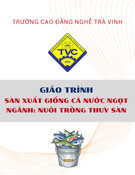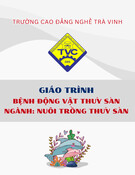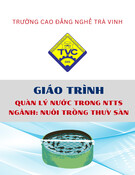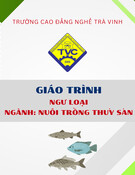
T
ẠP CHÍ KHOA HỌC
TRƯ
ỜNG ĐẠI HỌC SƯ PHẠM TP HỒ CHÍ MINH
Tập 21, Số 9 (2024): 1668-1681
HO CHI MINH CITY UNIVERSITY OF EDUCATION
JOURNAL OF SCIENCE
Vol. 21, No. 9 (2024): 1668-1681
ISSN:
2734-9918
Websit
e: https://journal.hcmue.edu.vn https://doi.org/10.54607/hcmue.js.21.9.4213(2024)
1668
Research Article1
SYNTHESIS HETEROGENEOUS CATALYST FexOy/CaO FROM BLUE
CRAB SHELL FOR TRANSESTERIFICATION OF FISH FAT OIL
Tran Thi To Nga1*, Trinh Hoai Thanh2, Nguyen An Binh1,
Nguyen Thi Kim Thanh1, Ho Tuan Kiet1, Nguyen Phuc My Tran1
1Ho Chi Minh City University of Education, Vietnam
2Faculty of Food Science and Technology, Ho Chi Minh city University of Industry and Trade, Vietnam
*Corresponding author: Tran Thi To Nga – Email: ngattto@hcmue.edu.vn
Received: April 07, 2024; Revised: June 03, 2024; Accepted: July 11, 2024
ABSTRACT
Nowadays, biodiesel attracts much attention since it is renewable, sustainable, and can
replace fossil fuels. CaO was a suitable heterogeneous catalyst for transesterification reaction to
produce biodiesel. In this study, blue crab shell was recycled as the CaO source. CaO was combined
with iron oxide to form a bifunctional catalyst, which was applied for the transesterification of fish
fat oil in an autoclave reactor. The catalyst characteristics, i.e. thermal degradation property,
morphology, and composition, were studied by TGA and SEM-EDX. The effect of catalyst,
temperature, reaction time, and MeOH: oil molar ratio was investigated. The results showed that
the addition of Fe can enhance the reaction rate. The reaction temperature and MeOH: oil molar
ratio affected the reaction time and catalyst loading more significantly than the FAME yield. The
highest FAME yield (84.28%) was achieved at 140
°
C, 2h, 10wt% FexOy/CaO catalyst and 20:1
MeOH: oil molar ratio.
Keywords: biodiesel; blue crab shell; calcium oxide; iron oxide; fish fat oil
1. Introduction
Renewable energy attracts numerous research and projects to find alternative energy
sources to replace fossil fuels. Biodiesel is a renewable, sustainable, and environment-
friendly fuel produced yearly, especially in the EU, Brazil, and the US (Ooi et al., 2021;
Spence et al., 2022). Biodiesel has shown remarkable industrial growth in two recent decades
since its lower greenhouse gas emissions are biodegradable and nontoxic (Pasha et al., 2021;
Talha & Sulaiman, 2016). Raw materials for biodiesel production are very diverse e.g. edible
oil (soybean, canola, palm oil, fat…) or inedible oil (waste cooking oil, Jatropha Curcas,
rubber seed, microalgae, neem seed…) (Amenaghawon et al., 2022; Amesho et al., 2022;
Cite this article as: Tran Thi To Nga, Trinh Hoai Thanh, Nguyen An Binh, Nguyen Thi Kim Thanh,
Ho Tuan Kiet, & Nguyen Phuc My Tran (2024). Synthesis heterogeneous catalyst FexOy/CaO from blue crab
shell for transesterification of fish fat oil. Ho Chi Minh City University of Education Journal of Science, 21(9),
1668-1681.

HCMUE Journal of Science
Vol. 21, No. 9 (2024): 1668-1681
1669
Baloch et al., 2018; Shankar & Jambulingam, 2017). Generally, biodiesel can be produced
by transesterification of triglycerides in oil with alcohol in the presence of a catalyst
(homogeneous, heterogeneous and enzyme) or without a catalyst (supercritical fluids)
(Kosuru et al., 2024; Pasha et al., 2021).
Biodiesel is produced economically via transesterification utilising the homogeneous
base catalysts, e.g. NaOH or KOH. The homogeneous catalyst process has some benefits,
i.e. shorter reaction time and inexpensive, but it quickly gets saponification, and there is no
way to recycle the catalyst (Kosuru et al., 2024). In contrast, the heterogeneous catalyst has
higher efficiency, is eco-friendly, and has no saponification (Talha & Sulaiman, 2016).
Numerous solid catalysts were applied in transesterification, such as CaO, CaO/Al2O3, MgO,
MgO-Li, Fe3O4/CaO, Na-SiO2, zeolite X, SO4/ZrO2, etc. (Kosuru et al., 2024). CaO is the
most popular heterogeneous catalyst for biodiesel production since it is a strong base
catalyst, nontoxic, cheap and insoluble in methanol (Kosuru et al., 2024; Palitsakun et al.,
2021). Mainly, CaO can be synthesised from waste sources of food industrial and
agriculture, e.g. eggshells (Attari et al., 2022; A.V.S.L.Sai et al., 2020; Yusuff et al., 2022),
crab shell (Cardoso et al., 2020; Ismail et al., 2022; Shankar & Jambulingam, 2017), clam
shell (Niju et al., 2016; Risso et al., 2018), oyster shell (Hernández-Martínez et al., 2023;
Risso et al., 2018), snail shell (Aisien & Aisien, 2023; Phuttawong et al., 2015), etc. Using
these raw materials help to reduce not only processing cost but also environmental issues
(Hernández-Martínez et al., 2023).
To improve the activity of CaO catalyst, researchers usually combine it with an
alkaline, alkali earth metal, or transition metal oxide (Aisien & Aisien, 2023; Hernández-
Martínez et al., 2023; Palitsakun et al., 2021; Xia, Hu et al., 2022; Xia, Li et al., 2022).
Results showed that the combination of group 1 and 2 metal oxide enhanced the reaction's
strong base sites and active site (Hernández-Martínez et al., 2023; Palitsakun et al., 2021).
Recent research revealed that the addition of transition metal oxide, e.g. CoO, NiO or Fe2O3
enhanced not only the active sites but also the specific surface area of the catalyst, resulting in
a higher activity (Amal et al., 2024; Das et al., 2020; Sulaiman et al., 2021; Xia, Li et al., 2022).
In this research work, we added a small amount of Fe (i.e. 6.5 wt%) to CaO catalyst.
Then we applied the catalyst for transesterifying fish fat oil to produce fatty acid methyl
ester (FAME). CaO was synthesised from the shell of a blue crab (Portunus pelagicus),
which is very popular in Viet Nam’s seafood. Meanwhile, Hu fish (Pangasius
conchophilus), a common catfish in Vietnam’s aquaculture, has a surplus unused amount of
fat during fish processing. Utilising these waste materials can produce valuable biodiesel
from the fish waste and reduce environmental pollution. Furthermore, the transesterification
was carried out in an autoclave reactor to provide a reaction temperature higher than the
boiling point of methanol (MeOH) (up to 160°C), increasing the reaction rate.

HCMUE Journal of Science
Tran Thi To Nga et al.
1670
2. Experiment
2.1. Material
Blue crab shell (BCS) was collected from markets and seafood restaurants around Ho
Chi Minh City. The catfish fat was obtained from the local seafood market’s waste.
Fe(NO3)3·6H2O (Reagent, Merck), Methanol (HPLC grade, Fisher), n-hexane (Xilong,
China), and double-distilled water were used as chemicals in the experiments.
The BCS was washed carefully to remove the contamination, then washed with boiling
water three times. The clean BCS was dried under sunlight for 6h and put in the oven at
105°C for 3h. After that, the sample was ground into small pieces (around 1mm). The dried
BCS was placed in alumina crucibles and calcined at 900°C for 4h in the muffle furnace (air
atmosphere), forming CaO sample. The CaO sample was finally ground and sieved to
0.125mm particles. The brown fine powder was kept in the desiccator for further processing.
The fish fat was washed with water and naturally dried for 1h before oil extraction.
The traditional method of extracting oil from fish fat is heating the fat until the yellow oil
(FFO-1) was removed from the solid. Moreover, the Soxhlet extraction was applied to
extract oil from the fish fat using n-hexane as a solvent for 4h. The n-hexane was removed
from the product by a vacuum evaporator, and then the light-yellow oil was obtained by
FFO-2. FFO-2 was extracted with MeOH to remove all polar components and free fatty acid
(FFA). This final fish fat oil was named FFO-3. The yield of these oils is listed in Table 1.
Table 1. The yield of oil extracted from fish fat by different methods.
Fish fat oil
Yield, wt%
FFO-1
75.15 ± 8.55
FFO-2
91.40 ± 1.35
FFO-3
81.94 ± 0.56
2.2. Catalyst preparation and characterisation
The FexOy/CaO was prepared with co-precipitation method. The mass ratio of Fe/CaO
was fixed at 1/14 (around 6.54 wt% Fe). The CaO was dissolved in 500mL of double-
distilled water in a beaker and placed on a stirred hot plate. Solution of Fe(NO3)3 was
dropped slowly into the mixture of CaO and water, set at 60°C. The system was stirred for
4h, then cooled to room temperature, and let the precipitation settled down. The precipitation
was filtered and dried at 105°C for 14h. Then, it was ground and calcined at 500°C for 4h.
The final FexOy/CaO catalyst was sieved to 0.125mm particle size and stored in the
desiccator for further experiments.
The synthesis catalyst was characterised by TGA-DSC (the simultaneous
Thermogravimetric Analysis (TGA) and Differential Scanning Calorimetry (DSC)) and
SEM-EDX (Scanning Electron Microscopy and Energy Dispersive X-ray Analysis) to study
thermal degradation property, elemental composition, and morphology. TGA-DSC was
performed on the TGA/DSC 3+ (Mettler Toledo). The TGA experiment was carried out on a

HCMUE Journal of Science
Vol. 21, No. 9 (2024): 1668-1681
1671
TGA LABSYS Evo 1600. The samples were placed in the platinum crucible; the oven was
raised from room temperature to 800°C (TGA) or 1000°C (TGA-DSC) with a ramp rate of
10°C/min in air. Furthermore, SEM-EDX was applied to study the surface morphology and
elemental composition by JSM-IT200 IntouchScopeTM SEM-EDX (JEOL - Japan). The sample
was sputter coated with a palladium ultrathin layer before SEM-EDX analysis.
2.3. Transesterification reaction
The experiment was conducted in an autoclave reactor. The reactants and catalyst were
added to a 100ml Teflon container and then placed inside the stainless-steel reactor. The
reaction was carried on inside the muffle furnace with a heating rate of 10°C/min, and the
furnace temperature was considered the reaction temperature. After the reactions were
completed, the system was gradually cooled to room temperature, condensing the solvent.
Then, all the products except the catalyst were transferred to cylinders and kept for one day
for gravity settling, leading the catalyst to sink to the bottom. Furthermore, the liquid phases
were transferred to the separatory funnel and washed several times with methanol or water
to remove all glycerol. The final product was dried in the oven at 105°C for 30 minutes.
The product was analysed with GC-MS (Gas chromatography/mass spectrometry) to
calculate the yield of FAME formation. The GC-MS Agilent GC6890 system was applied
with HP-5MS (30m x 250μm x 0,25μm) column. The sample was diluted with n-hexane,
and methyl heptadecanoate was used as the internal standard (ISTD). The inlet was kept at
250°C, with a split ratio 1:50. Helium was used as a carrier gas. The FAME yield was
determined by equation (1)
𝐻𝐻% = 𝛴𝛴𝐴𝐴𝐹𝐹𝐹𝐹𝐹𝐹𝐹𝐹
𝐴𝐴𝐼𝐼𝐼𝐼𝐼𝐼𝐼𝐼
∙𝑚𝑚𝐼𝐼𝐼𝐼𝐼𝐼𝐼𝐼
𝑚𝑚𝑠𝑠
∙100% (1)
Where: 𝐴𝐴𝐹𝐹𝐴𝐴𝐹𝐹𝐹𝐹 , 𝐴𝐴𝐼𝐼𝐼𝐼𝐼𝐼𝐼𝐼 are the peak areas of FAME and ISTD
𝑚𝑚𝑠𝑠, 𝑚𝑚𝐼𝐼𝐼𝐼𝐼𝐼𝐼𝐼 , which are the mass of the sample and ISTD in the solution.
3. Results and discussion
3.1. Catalyst characterisation
The simultaneous TGA-DSC curves of BCS showed three mass loss ranges (Figure
1). The first one was from room temperature to 210 °C, corresponding to the evaporation of
physically adsorbed water. The second range of 210−500°C showed a mass loss of 23.1%,
attaching to an exothermic peak in the DSC curve. This mass loss was assigned to the
degradation of organic compounds in BCS. The last mass loss was observed at 815−860°C,
which corresponded to the degradation of CaCO3, yielding CaO as the final product. An
endothermic peak observed simultaneously at the DSC curve reinforced this phenomenon.
The degradation of CaCO3 in this research showed a higher degradation temperature than in
other research, such as crab shell (Correia et al., 2014), eggshell (Correia et al., 2014;
Rahman et al., 2022; Yusuff et al., 2022) and oyster shell (Hernández-Martínez et al., 2023)…
which almost degraded completely before 800°C. However, the chicken eggshell in Attari’s
research degraded completely at 877°C, higher than this study. The different degradation

HCMUE Journal of Science
Tran Thi To Nga et al.
1672
temperatures of CaCO3 observed from various studies might come from the type of equipment,
sample weight, particle size, and the heating program… However, all research had chosen 900°C
for the calcination of raw material to synthesise CaO. The mass loss of CO2 of about 24.5%
provided the per cent of CaCO3 in raw BCS about 55.7%, which is lower than another shell type
(Correia et al., 2014). This TGA-DSC result set the calcination temperature at 900°C to
synthesise CaO from BCS.
The uncalcined FexOy/CaO was analysed with TGA from room temperature to 800°C
in the air; the result is presented in Figure 2. Three main weight losses are observed in the
TGA curve corresponding to 3 sharp peaks in the derivative thermogravimetric (DTG) curve.
The peak at 117°C was considered as desorption of physisorbed water. At the same time, the
decomposition of iron hydroxide and calcium hydroxide was assigned to the peak at 387°C
with the mass loss of 7.9%. Ca(OH)2 formed when water was added during preparation. At
the same time, Fe(OH)3 precipitate was produced when Fe3+ encountered a base medium.
The third mass loss at 450°C should be the degradation of nitrate salts. This peak is not high
since the Fe percentage in the final catalyst is only 6.48wt%. The last peak at 640°C gave a mass
loss of 5.1%, corresponding to the degradation of CaCO3. This carbonate species of Ca had lower
degradation temperature than the one in BCS in Figure 1, which two reasons can explain. Firstly,
two different TGA equipment analysed BCS and uncalcined FexOy/CaO. Secondly, this
carbonate species was an external coating of CaCO3 formed in an uncalcined FexOy/CaO sample,
which resulted from the recombination of CaO fine particles and CO2 in the air during the
storage, preparation, and calcination processes. These made CaCO3 appear in uncalcined
FexOy/CaO samples with a low amounts and at the outer surface, leading to an earlier
degradation peak (Hernández-Martínez et al., 2023).
Figure 1. Simultaneous TGA-DSC results of blue crab shell - BCS in air


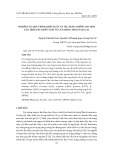

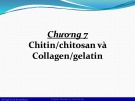




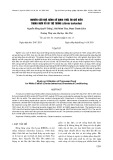





![Giáo trình Sản xuất giống tôm nước lợ, mặn (Trung cấp/Cao đẳng) - Trường Cao đẳng nghề Trà Vinh [Mới nhất]](https://cdn.tailieu.vn/images/document/thumbnail/2025/20251115/kimphuong1001/135x160/76031763179346.jpg)

